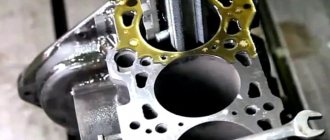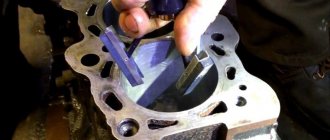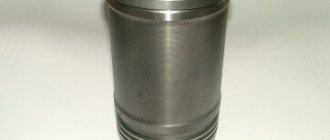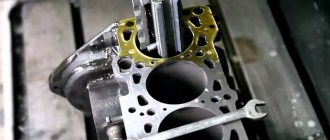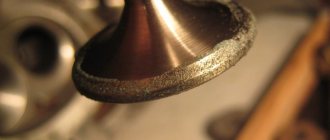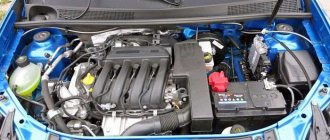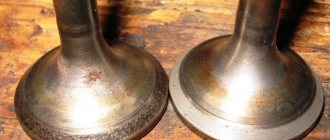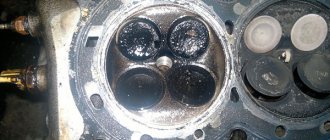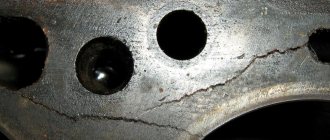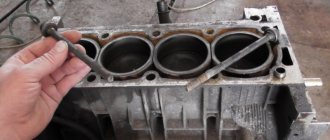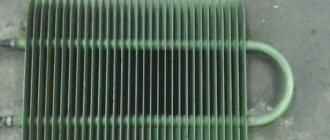Honing the cylinder block
The final stage of overhaul of a car engine is considered to be honing the cylinder block, which by reducing the roughness of the cylinders ensures smooth movement of the piston.
Why is cylinder block honing necessary?
As you know, the power unit of any car loses its original properties during operation, which negatively affects its operation. If you look at the exhausted cylinders in cross-section. Then you can see marks and scratches, which in turn affects the engine power - it decreases, as well as the consumption of fuel and engine oil increases and compression is lost.
If engine repairs are not carried out on time, the poor condition of the cylinders will affect the performance of other mechanisms and can lead to failure of other important mechanisms
Honing process
Boring and honing of cylinders is carried out in several stages:
- Roughing, which is performed using abrasive materials and returns parts to their original condition.
- Cylinder boring. This action is performed using special abrasives
- Honing. It is performed using a ceramic or diamond coated stone, which is fixed to the honing head and moves up and down. Such a device is capable of performing honing with high precision.
- Cleaning the treated cylinder. This action is performed using a special paste.
Advantages of Honing and Boring
Honing the cylinders of a car's power unit increases the pressure level in the cylinders to the maximum, which increases its efficiency.
The boring forms a special mesh on the surface of the cylinder, which retains oil and when the engine is in working condition, the parts interact and are constantly lubricated with oil.
Honing work requires special equipment. In particular, for boring you will need 5-8 bars, which are located along the surface to be processed. This tool is installed using a hydraulic drive. It is noteworthy that the boring bars are made in such a way that the diamond coating is self-sharpening.
Honing cylinders at home
Even if a motorist decides to hone the engine cylinders himself, it is difficult to do this without special equipment. But flat-top honing is quite accessible at home and is performed in two stages:
- First, the master carries out rough cleaning, removing damaged layers of the cylinder and leveling out roughness.
- Then the master works with fine abrasive, achieving high precision, and smoothness is ensured through the use of pastes.
Experts advise that when working independently, do not neglect the procedure for cleaning the engine from dirt and metal particles.
See all photo news >>
But why "Mechanics"?
We mentioned above - and for good reason. He is a recognized expert in engine repair. And here are the arguments.
Automotive engines are changing rapidly. The power increases while the size of the unit is reduced. Thermal and mechanical stress on parts is increasing. This means that structural materials for piston rings, pistons and cylinder blocks are being improved. The rings themselves also change - their height decreases, and the number of rings decreases.
You need to know all this, continuously monitor all industry news, and above all, innovative solutions from engine manufacturers.
So, Mekhanika employees keep their finger on the pulse of the global automotive industry. But classical technologies are not forgotten either. Therefore, both the good old naturally aspirated engine and the newest turbocharged unit, born under the downsizing banner, will be repaired here.
As already mentioned, accurate diagnostics are carried out here. This means choosing the right repair technology.
This company has an excellent machine fleet, including modern Sunnen honing machines. And experienced craftsmen work for them. These will not “loose” tolerances; they feel the metal intuitively.
(photo: BC honing machine)
The tools - honing stones and brushes - are imported here. Cutting fluid (coolant) of the highest quality. It washes the instrument and block during the operation, is immediately filtered and again supplied to the working area.
Differences in honing performance on different engines
Internal combustion engines have different designs. The design schemes used influence the technological process.
Unlined motors
The unlined block, made as a single part, is processed immediately after boring, secured on the work table and making sure that the axis of the cylinder being processed is vertical and coincides with the axis of the honing machine spindle. This will prevent it from being perpendicular to the crankshaft. The spindle of the turned on machine rotates, simultaneously performing reciprocating movements. It may take one to several passes to achieve the desired result. Dimensions are controlled using a bore gauge. At the same time, surface roughness measurements should be taken. There are various ways to do this:
- Contact (probe), for which special devices have been developed - profilometers and profilographs. The latter not only measure, but also record parameters.
- Non-contact (optical), among which there are shadow, light glow, raster and micro-interference.
Carefully performed processing increases the power of the internal combustion engine, the quality of its operation and service life.
Sleeved motors
Honing engines with dry or wet liners poses a separate problem. Manufacturers of spare parts supply, as is commonly believed, ready-to-use sets of sleeves that have already gone through all stages of processing. However, under the influence of various factors, parts installed on workplaces are deformed and no longer correspond to the specified dimensions. Consequently:
- Compression gets worse. The engine does not develop the necessary power and consumes a lot of fuel.
- The resource of the power unit is reduced.
There is a way to avoid these troubles. For this purpose, a special thick plate is made that imitates the cylinder head. It should press the liners, while at the same time having through holes that provide unhindered access for the tool inside the cylinders. The plate is secured to the block after installing the liners, tightening the threaded connections in the sequence and with the tightening torque recommended for installing the cylinder head. Only after this, honing is performed in the same sequence as for unlined motors. This makes it possible to minimize dimensional distortion that occurs during the installation of sleeves.
If the technological cycle is fully observed, the procedure is performed in four stages:
- Rough processing, during which a significant layer of material is removed. It can replace the boring. It is carried out with excess coolant. Hones with copper-based diamond bars are best suited for this purpose.
- Honing with a tool with a grain size of abrasive material 1/150 mm. In this case, a surface microprofile is formed.
- Final processing with material with a grain size of 1/300 – 1/500 mm.
- Brushing. This is the final operation, during which the size of the cylinder does not change, but the surface is cleaned of abrasive residues. For brushing, nylon brushes are used, the fibers of which contain silicon crystals.
Compliance with these rules allows you to achieve optimal results.
How to bore a cylinder correctly
Although, we must be honest, modifying the cylinder head with your own hands is only partially possible. You can disassemble the cylinder head and dismantle the cylinder block with your own hands. You yourself can measure the gap between the piston and cylinder and even liner it.
But the further procedure - boring the cylinder head can only be carried out using specialized equipment.
If honing cylinders in some cases can be done with your own hands using a manual honing head and an electric drill, then turning cylinders is a long and special technological process.
With your own hands, you can later, after boring and honing the cylinder block, assemble the unit.
Most likely, you yourself will not stand at the machine, but it will not hurt you to know the technology for boring the cylinder head.
Most often, cylinder boring is necessary to increase the volume of the socket for the repair kit. In this case, you should already know for what size of sleeves the boring will be done.
For boring, special boring machines are used. Due to their high cost, not every service station can afford to have such a machine. Therefore, as a rule, in cities there are only a few technical centers where cylinder heads are modified.
Turning cylinders is not a quick procedure and requires high precision. Boring occurs at low speed. This ensures high surface quality and accuracy up to 0.01 mm.
When processing the surface of a cylinder on a machine, all cylinders are parallel along their length while being perpendicular to their base—the plane. Taking into account some “curvature” of the blocks, parallelism to the crankshaft beds is ideal.
In the process of boring cylinders, an allowance must be left for honing the cylinders. This is approximately 0.1 - 0.15 mm.
Why so many? This layer of metal is defective after boring and is removed (polished) by honing. And such a small allowance prevents the cylinder axis from skewing during honing.
What to do if seizures appear in the engine
It was already noted above that bullies must be dealt with immediately. If you ignore the problem, the condition of the motor will quickly deteriorate. Wear will increase: a small malfunction will cause the next one. Problems will grow like a snowball.
If the scuffs are still very small
When the seizures are very small, you can solve the problem without disassembling the engine. If wear does not exceed tenths of a millimeter, buy and add a special additive to the oil, for example, Active Plus from the Russian one.
This product forms a metal protective film on friction pairs. The special structure of the layer allows you to restore worn surfaces (with small deviations from standard dimensions and geometry).
It is necessary to strictly follow the instructions, both when using the Suprotec tribo composition and when using products from other manufacturers. Exceeding the permissible dose may lead to the opposite result. Even if there is no harm to the mechanism, you will simply be wasting your money.
Suprotek Active Plus additive in engine oil
Restores compression, reduces fuel consumption and oil waste, reduces wear rate and extends the life of internal combustion engines of any type. Facilitates cold starts and protects against overheating in traffic jams.
When additives don't help
If the use of additives does not give the desired result, then the scuffing is already too large. In this case, boring and honing of the internal combustion engine cylinders is required. This operation can be ordered from a car workshop, or performed independently.
You should only undertake honing cylinders yourself if you have plumbing skills. It is necessary to maintain high precision: the pattern formed on the metal must be uniform, the strokes must converge at the same angle.
For this work you will need a special honing device - honing. Two types of these devices are produced - in the form of a “brush” and in the form of a structure of three bars on a central rod. In garage conditions, it is better to use a brush. The grinding stone attachment is more suitable for boring machines.
- The hone needs to be inserted into the drill chuck. To ensure accurate orientation, you need to use at least the simplest devices: a feed rail and a level. If the accuracy of the stroke is violated, the honing will be defective. We'll have to redo it.
- Throughout the operation, it is necessary to ensure that the surface being treated and the cylinder honing device are irrigated with a sufficient amount of lubricating fluid. As a rule, kerosene or its mixture with oil is used.
- Upon completion of the operation, it is necessary to clean the engine from chips and remaining abrasive material. Use a soapy solution to wash away any solids. When the walls are dry, treat them with a special oil that prevents corrosion.
- After honing, it is recommended to give the engine some time for the cylinder-piston pair to break in. During this period, overload should be avoided and the quality and volume of engine oil should be closely monitored.
To make the running-in process better and more gentle, you can use the tribocompound Suprotec Active Plus and an analogue. The advantage of a product made in Russia is its reasonable price. In terms of operational characteristics, Suprotek Active Plus has no foreign analogues.
The main advantage of do-it-yourself honing is that the engine does not have to be removed from the car. This greatly reduces the operation time. At the same time, it should be remembered that if the cylinders have a high degree of wear, this measure will not help - boring, polishing and then honing are required.
What is engine cylinder honing?
While the car is moving, the engine is subjected to high loads, as a result of which natural wear and tear occurs. The engine changes its characteristics as engine hours are accumulated and at some point requires repair. The condition of the working surface of the CPG is the main criterion for the health of the engine. Honing of the cylinder block is required if burrs and scratches appear, as well as if there is a taper.
During a major overhaul, a mechanic bores a completely disassembled block to the nearest repair size, which allows you to remove defects in the mirror and eliminate deviations in taper and ellipse. The smooth mirror surface after boring looks very impressive, but for better engine performance it is necessary to create notches on it. This is also done on a lathe with a special tool - a hone. With proper skill, you can perform this operation manually, but the quality will be noticeably worse.
Repair technology is constantly improving. Currently, all manufacturers have switched to flat-top honing. With this treatment, the notches do not have sharp edges (tops) that come into contact with the piston and rings when the engine is running. After boring, the mechanic must reproduce the same structure of the mirror. Properly performed repairs facilitate the process of running in the engine and ensure optimal clearances between parts. Such a motor will not consume oil and will provide maximum mileage until the next major overhaul.
Cylinder block honing is the procedure of applying a mesh to the working surface of the engine block. It allows you to provide the engine with the best lubrication conditions for rubbing parts. Engine oil is retained in the grooves formed by the hone.
Honing is carried out in two stages. First, a coarse abrasive is used, which produces large notches. Then a finishing treatment is applied, smoothing out defects and unevenness from the previous operation. There are diamond and ceramic markings. The first is preferable due to higher processing accuracy, but is more expensive. The second method is used more often due to the greater affordability of the price of work and the cost of equipment. Automakers can use laser finishing that is not possible in artisanal settings.
At the end of work, the unit must be thoroughly rinsed. It is advisable to do this with a jet of air or coolant under pressure. It is necessary to ensure not only the external cleanliness of the part, but also to wash metal shavings and abrasive paste residues from hidden cavities. Ceramic and metal particles left in the engine can cause irreparable damage. In order to smooth the surface, finishing sanding is used after roughing.
Features of honing tools
The honing tool is the head. It contains the adjusting rod 1. By changing its length (tightening or unscrewing the nuts), the position of the abrasive bars is changed.
A double-sided conical adjustable rod 1 is mounted inside the head, through which the radial rods together with the abrasive bars move apart, adjusting the diametrical size and compensating for the wear of the abrasive bars 4. Movement is possible up to 0.5...2.8 mm. As wear occurs, the turning size must be restored, so the machine operator has the opportunity to obtain the desired size without replacing the bars.
Special cylindrical clamps 5 do not allow changing the set size. The processing accuracy corresponds to class 1-2. You can achieve a mirror-like shine of the resulting surface.
The honing head is used with a special machine 3G833. It has a vertical rigid shaft. It allows you to obtain rigid rotation of the tool without signs of runout.
Design of the honing head: 1 – rod for changing the outer diameter of the hone extension; 2 – workpiece; 3 – spindle; 4 – abrasive bars; 5 – cylindrical clamp
External honing is performed on a fixture that can be mounted on lathes. For large machines such as DIP-300 or DIP-400, an external honing head KhNP-150 is used. It allows external polishing of parts with a diameter of up to 150 mm.
External honing head KhNP-150: 1, 2, 7 and 8 – abrasive stones; 3, 6 – locking expansion pads; 4, 5 – brackets for fixation
The part is installed into the machine spindle. A honing device is located on the caliper. The rotating part is in the zone of action of the bars, which grind the surface. The tool is fed longitudinally in different directions.
Description
Purpose
It is used for finishing the working surfaces of internal combustion engine cylinders, brake cylinders and other internal cylindrical surfaces that require precise geometric dimensions and roughness parameters.
Description
• For cylinders with a diameter from 32 to 89 mm • Hon grain size: 220* • Cylindrical shank with flexible extension • Spring-loaded hone supply mechanism • Spring stiffness adjustment nut
* a set of replacement hones (stones) is also supplied separately.
Honing is a process of treating a metal surface using diamond chips. It is mainly used for grinding conical and cylindrical parts. This operation is convenient when making holes. The resulting surface roughness value corresponds to the level of fine turning or grinding with a coarse-grained abrasive wheel. Only the honing method can achieve the desired result when working with a cylinder block. At the interfaces between parts there must be lubricant, which is held in place by a specially applied honing mesh.
The honing tool used is called a hone. These are bars or stones that are placed around the perimeter of the base. During operation, they are erased, so the design of the clip allows for the possibility of replacing them.
Special machines are used for the honing process. These are devices with a horizontal or vertical arrangement in the spindle space. Each of them has its own purpose depending on the work being done. Honing equipment is specialized for narrow profiles. The production of universal machines is a thing of the past.
Caseless engines
Hone treatment differs on liner and linerless engines. If you need to process a linerless cylinder block, there should not be any particular difficulties.
The solid metal structure is securely fixed to the machine table immediately after the boring process. You should make sure that the sleeves are positioned strictly vertically and that no displacements will occur during the reciprocating movement of the cartridge - otherwise there will be no benefit from the processing.
When machining linerless cylinders, only a few machine passes are required.
In this case, it is necessary to strictly control the resulting dimensions and surface roughness. An indicator bore gauge (monitors dimensions) and a profilometer or optical device for measuring the level of roughness will help with this.
Replacing the piston and boring the cylinder
If such a situation occurs, then replacing the piston alone does not solve this problem.
It needs to be solved comprehensively, i.e. replacing a piston plus boring a motorcycle cylinder. Those. cylinders must be bored every time their wear has been detected. It is also worth considering that not all cylinders are subject to wear, even after quite a long period of operation in very difficult conditions. There are also cases where a vehicle lives out its life without ever boring the cylinders. Parameters for determining cylinder wear:
- if at the top dead center of the cylinder its dimensions have changed by 0.05 mm from the original ones;
- if in the place where the piston skirt and the cylinder wall come into contact, the size has changed by 0.03 mm.
Thus, the two indicated parameters may well answer the question of whether or not it is worth boring the cylinder. If there is at least one of the changes listed above, then the answer is obvious - boring is necessary.
There are also worse situations when a so-called “stepped” defect appears in the upper part of the cylinder. The resulting step reduces the wear time of the cylinder, piston rings, and ring seats on the piston, resulting in very noticeable shocks during driving. However, this defect becomes noticeable without any measurements. When it changes, the nature of the engine's operation changes - it begins to vibrate strongly.
This is a direct indication for immediate repair, since the ellipsoidality accompanying this defect leads to the fact that the piston rings adhere worse to the cylinder walls. This, in turn, can lead to breakthrough of gases from the cylinder into the crankcase, disruption of compression in the engine, which also increases oil and fuel consumption.
In this case, boring the cylinders will help restore the necessary parameters of this part of the engine. However, by boring we mean not only the restoration of the geometric parameters of the motorcycle cylinders, but the restoration of the normal position of the mating parts relative to each other. In other words, if you only correct the geometry of the cylinder, it will not be enough to restore normal alignment and the normal location of all the main surfaces.
The consequence of this is the appearance of excess friction, which affects other structural components of the piston group. In other words, all moving parts that participate in the operation of the engine and are part of the piston group will be subject to additional bending, compression, etc. loads. This, in turn, can cause further breakage of the cylinders as the engine operates.
However, nowadays there are still masters who want to carry out this process on their own. Perhaps some people don't have enough money, while others just like to spend time in the garage, tinkering with their motorcycle. In any case, it is possible to bore a motorcycle cylinder yourself. It is worth noting right away that the boring method is also suitable for an automobile cylinder block. The only caveat is that turning to a turner is inevitable, since it is the turner who can make the appropriate mandrel that is suitable for this process.
The mandrel should have dimensions depending on the size of the cylinder being bored. For example, if the diameter of the cylinder is 76 mm, then the diameter of the mandrel should be 74 mm, and its length should exceed the length of the cylinder by approximately 150 mm, although a little more is possible. After the mandrel is ready, you need to make a hole in it into which the knob will be inserted, and use a hacksaw to cut a groove along the groove, the depth of which should be approximately 10 mm.
Features of the technological process
Honing is a term that appeared in metal cutting technology from England in the 17th century. When creating large-caliber weapons, it became necessary to process the inner surface of the guns. A short barrel (5-7 calibers) made it possible to accelerate the cannonball to a speed of 340-360 m/s. Using a barrel with a length of more than 10-12 calibers, you can increase the speed to 450-480 m/s. Accordingly, the range of hitting a target almost doubles. For naval battles this is a great advantage. You can destroy enemy ships without coming under fire from their guns. The problem of processing the cylinder inside was solved with the help of hone (honing - sharpening stones, honing English - sharpen).
The first installations were of the horizontal type. In them, the bars were installed motionless, and the rotation was transmitted to the trunk. The cast iron product weighed about 500 kg; in a couple of hours of work, a surface close to ideal was obtained. At the same time, the core was also adjusted. We tried to obtain casting balls with minimal clearance.
This type of operation became most widespread with the development of steam thermal power plants. Long working cylinder (9-14 gauge). The piston moves in it. The movement occurs due to the supply of steam from a steam boiler.
External honing is necessary for long parts. These are found in the weaving industry, where rocker mechanisms are used. They have a complex reciprocating motion, converted from rotational. The stone, as the part is called, moving along a cylindrical surface, moves forward along the slide. The resulting movement is used to move the shuttle between the threads of the future fabric.
- dry honing, performed without the supply of lubricating coolants (coolant);
- wet, performed when coolant is supplied to the processing zone.
Result of surface honing: micro-roughness before processing (a); smoothed microroughnesses after turning (b)
Full leveling does not occur. Only the sharp points are ground down. Fractions of a millimeter are removed, but this is already enough so that the parts provide minimal resistance when moving mutually.
In an internal combustion engine, the lubrication system forces the supply of lubricants. They settle in the spaces between the peaks. For example, in the MeMZ-968 engine (used in the ZAZ-988M), the gap between the piston and the cylinder wall was only 0.062 ± 0.004 mm. In modern automobile internal combustion engines, this value is at the level of 0.032 ± 0.0027 mm. Better sealing allows more efficient use of gas pressure in the working cylinder.
Main advantages
Honing parts has a number of positive aspects. Benefits include:
- After honing, the surface layer of parts acquires increased strength, which affects the duration of their operation.
- Significantly lower percentage of defective parts. This is due to the fact that the honing tool does not create much pressure on the surface of the product.
- Wide range of honing tool grits. This makes it easier to reach the desired level of requirements for the workpiece.
- With the help of a hone, it is possible to eliminate defects when drilling holes on a machine.
- At the same time, several holes are honed on the equipment, which increases the speed of work.
Read more: Alternator repair for Volkswagen Golf 2 3 4 Polo Sedan and Passat B3 B5, do-it-yourself belt replacement
Hon in a top hat, what is this?
Cylinder honing, along with boring, are integral attributes of engine overhaul. Let's consider what honing is, how the final processing of liners, cylinders, bushings is carried out and what tools and equipment are needed for do-it-yourself repairs. Let's answer the question, which is better: a mirror or a hon?
Purpose of application
Reasons for cylinder honing:
- approaching the ideal geometric shape of liners, cylinders, bushings. Due to the error of even the best quality boring tool, after boring the cylinder may have a slightly barrel-shaped, cone-like shape. Any change in the shape of the cylinder from the ideal geometry of the circle and a displacement of the axis of the hole in the engine cylinder block leads to a decrease in compression and a decrease in the service life of the cylinder-piston group;
- The accuracy of surface treatment with a hone is significantly higher than in the case of processing with boring and grinding tools. This feature allows you to obtain the required surface cleanliness class and achieve a better fit of the piston rings to the cylinder walls;
- obtaining the required roughness structure. The correct notch allows you to hold motor oil on the cylinder walls, preventing dry friction of rubbing pairs and, as a result, accelerated wear of CPG parts. Also, ordered roughness prevents severe wear of parts when, for certain reasons, short-term dry contact of rubbing pairs occurs.
Processing technology
The essence of the honing process is to uniformly remove micron layers of metal. For this, a special tool is used - a hon. The working surface of the honing head touches the inside of the surface being machined along a trajectory combining rotational and reciprocating movements.
The treatment is carried out using a special cutting fluid, which can be kerosene or a working fluid based on water-oil emulsions (used when processing products with high requirements for coating quality).
During the honing process, it is extremely important to ensure uniform pressure on the grinding edge, since only in this case will it be possible to obtain a uniform scoring depth and a nearly ideal geometric shape of the inner surface of the cylinder. To eliminate possible uneven processing, the rod sets the hone to small circular vibrations around its axis
Subtleties of the process
- should not have torn or sharp edges;
- there are no deformed areas;
- depth and width must be uniform.
Honing Tool
For honing cylinders with your own hands, 2 types of amateur tools are used:
- flexible honing brushes (bottle brush). The device is an attachment for a hand drill or screwdriver, at the end of which there is a honing brush. Grinding stones mounted on spring legs are used as abrasive materials;
- 3-jaw attachments for manual honing. Grinding stones are used as abrasive materials. The tool rod can be fixed in the chuck of a screwdriver or drill.
The feasibility of do-it-yourself repairs
You should resort to self-honing of cylinders only if it is not possible to use machining. When honing with your own hands, it is impossible to create an orderly roughness.
Not only the amplitude and nature of the movements will depend on the position of the drill, but also the force of pressure of the stones on the walls of the cylinder and liner. Of course, there can be no talk of bringing the form to geometric ideals.
If you still decide to hone the cylinders yourself, it is better to use 3-legged devices.
Hon or mirror?
The mirror surface of the cylinder is distinguished from the hone only by the class of surface finish. The belief that hone destroys piston rings, and therefore for long-term operation of the engine the walls need to be ground into a “mirror”, arose only from non-compliance with proper honing technology.
To put an end to the debate about honing and mirrors once and for all, to find out what honing is and how it is done correctly, we recommend that you watch the video.
DIY honing head
- 1 Honing: processing of engine cylinder block holes, types of honing heads
- 2 How cylinder honing is performed and what it is: advantages of the procedure and technology
- 3 Honing, what is cylinder honing during engine overhaul. What is cylinder honing? DIY cylinder honing
- 4 Repair of cylinder block by honing and equipment for it
Honing is one of the technological process operations that performs finishing processing of internal cylindrical holes using abrasive tools.
Mechanical engineering widely uses this type of processing to obtain high-quality surfaces in the cylinder block of an internal combustion engine during its manufacture or during major repairs.
The essence of the process
The machining process is similar to abrasive grinding, but honing occurs at low speeds .
The head makes two main movements: circular rotation and reciprocating movement along the vertical axis.
The rotation speed varies between 40−80 m/min, which is less than 100 rpm. The feed rate for such speeds does not exceed 16−20 m/min.
After several double strokes, the bars are spread apart. To remove a uniform allowance, the honing head has a floating mount. Honing can achieve 5-6 accuracy grades and 10-12 roughness grades.
During the movement of the abrasive bars, metal is removed in microscopic volumes.
On the surface of the hole, a pattern of marks is obtained, the intersection angle of which is 120°.
This allows lubricants to remain on the surface, reducing wear of rubbing parts.
Purpose of honing
Among the reasons for using hone are the following:
- the shape of the processed internal holes corresponds to the geometric parameters;
- high dimensional accuracy;
- low roughness;
- applying microscopic marks that form the correct pattern.
If the hole in the engine liner does not have the correct shape, this will lead to a decrease in compression and a decrease in the working life of the piston group.
Boring does not provide an ideal shape due to wear and bending of the cutting tool.
The shape may have defects such as coning and barrel-shaped.
Processing with a blade tool does not achieve the required cleanliness.
Because of this, during operation there is increased wear of the compression rings and, as a result, increased fuel and oil consumption.
Grooves with residual lubricant eliminate dry friction of parts.
Processing tool
For processing, a special honing tool is used - honing. Honing heads are classified according to the following characteristics:
- according to the method of attaching the abrasive tool:
- according to the method of ensuring size: adjustable;
- self-unclosing.
The honing head consists of:
- housings;
- abrasive bars;
- rod;
- control coupling.
The body has milled grooves into which abrasive stones are installed. A collet mechanism is provided inside the body, ensuring simultaneous and smooth ejection of the bars.
Abrasive stones are made from sintered composites or matrix diamond elements. The grain size does not exceed several tens of microns.
The coaxiality of the motor sleeve and the tool is ensured by the rod. The resulting hole diameter is adjusted using a coupling.
Self-unclosing hones are made in the form of a brush , which used to be used to wash milk bottles.
Small abrasive stones are attached to the ends of the spring legs.
This device is intended for use in conjunction with a hand-held electric drill or screwdriver.
Processing with such a head is close to fine grinding or polishing. The absence of rigid fastening does not allow the correction of surface defects after boring, but reduces the roughness to a value of Ra 0.25.
Carrying out work
To obtain a high-quality result, a honing machine is required. Such equipment is used in large specialized auto repair shops that repair diesel and gasoline engines.
The cylinder block is positioned and secured on the machine table so that the holes or liners are positioned strictly vertically. This is the main condition. The honing head is placed inside. The clutch adjusts the desired hole size.
The working surface of the bars will remove the tops of the micro-roughnesses remaining after boring. This method is called flat-top or plateau honing.
The processing process is carried out using working fluids .
Kerosene is used to process cast iron, and a mixture of kerosene and oil is used to process steel.
Coolant emulsions are increasingly being used. For example, 7% aqueous solution of NSC-5.
Interestingly, during honing, the surface is hardened to a depth of 0.06 mm.
When the pressure of the abrasive bars is equal to 5 kgf/cm2, the hardness increases by 10−15%.
When processing alloy steels and a pressure of 70 kgf/cm2, the hardness value increases to 70%.
DIY cylinder honing
Many home craftsmen independently repair their car engine.
The block is sent to the workshop for boring, and they try to do the rest of the work with their own hands.
Before starting work, it is necessary to acquire work skills.
For processing you will need a set of sandpaper having different grain sizes. For pre-processing, use large skins. And as micro-irregularities are smoothed out, the graininess of the paper decreases.
Honing occurs with abundant wetting with oil. The process is reminiscent of grinding parts with abrasive powder. Dimensions are checked in the absence of a bore gauge using a repair size piston.
How cylinder honing is performed and what it is: advantages of the procedure and technology
Most people who have only a passing knowledge of the technique cannot say what the term "honing" means.
This word is of English origin: “ to hone ” as “to grind”, “to sharpen”.
This term refers to the treatment of the internal surfaces of the cylinder.
Cylinder block honing theory
The honing process removes metal from the inner surface of the block cylinder in a manner very similar in nature to the grinding process. The essence of the treatment is that metal is removed with a special honing tool called a hone. The working surface of the hone touches the inner surface of the cylinder along a circumference of a certain width, usually very small. In this case, the hone itself, during processing, with the help of a honing device, moves up and down, strictly along the axis of the cylinder in the engine.
The hone design is a set of abrasive bars located around the perimeter of the tool and secured in an adjustable metal mandrel. Using a mandrel, the master can adjust the outer diameter formed by the working surface of the bars. At the top of the hone there is a coupling with which the hone is secured to a steel rod.
After placing the hone in the cylinder of the engine block, the alignment of the rod and the cylinder axis is carefully aligned; sometimes this requires moving and adjusting the position of the cylinder block. Then the hone mandrel regulates the reach of the grinding stones and the force with which they are pressed against the surface being processed. All of the listed preparatory operations for installing the engine block greatly affect the accuracy of processing, so they are always performed with the utmost care.
The process of honing the cylinder mirror is carried out using a special working fluid. In simpler operations, purified kerosene is used, and for honing particularly critical products, special cutting fluids based on water-oil emulsions are used. The most commonly used solution is a 7% solution of NSK-5 concentrate in water.
Special sintered composites based on micron cubic boron nitride powders or diamond-containing matrices with a metal binder are used as grinding stones.
The trick to honing is this:
- The main condition for successful honing of cylinders is to ensure uniform pressure of the grinding tool on the surface being processed - the mirror of the block cylinder. Thanks to this, the geometry of the hole is almost ideal;
- In addition to oscillatory movements along the axis of the block cylinder, during honing the rod imparts small circular vibrations to the hone around its axis. This eliminates possible uneven sanding due to differences in the quality of the sanding stones.
The quality of the mirror surface of the engine block cylinders after honing is almost close to the quality of the metal after superfinishing - processing with the help of the smallest micron abrasive powders to the state of a mirror surface. But, unlike the latter, honing processing has a productivity that exceeds superfinishing by more than 2.5 times.
When is honing needed?
There is no general time frame for when engine components will need this procedure.
Cylinders are honed when they reach a certain level of wear, and for each engine this will have its own operating time. Wear is affected by gasoline, the motor oil used by the car owner, driving style (driving pace), serviceability of related systems, etc. Note !
On average, work is carried out when the vehicle’s mileage reaches 100 thousand km or more.
External signs help determine that hone is already needed in the engine cylinders. The more intense the problem, the sooner treatment needs to be carried out. If the car owner notices one of the following markers, you should show the car to a mechanic for work.
List of possible signs:
- The appearance of blue smoke from the exhaust pipe.
- Instability of engine speed at idle.
- Reduced motor power.
- Increased oil consumption compared to previous measurements.
The need to apply hone to cylinder blocks is often caused by a complete combination of these factors - they are closely related. Blueish exhaust smoke occurs when the piston ring does not collect oil from the cylindrical surface without leaving any residue. Oil traces remain and burn together with the fuel. Since defects in the internal channel lead to empty combustion of engine oil, its consumption increases.
Boring will help increase the compression of the cylinder block
Video instructions, as a rule, clearly show this event, but the viewer misses the most important thing - the specifics of the event. It seems to him that everything is simple and easy, and he can handle it, but we must not forget that in the video a pro is boring the block
Most of all, cylinder block boring is of interest to car owners concerned about compression. Watching a lot of videos becomes a revelation for many. They understand that dealing with this matter correctly at home will be extremely difficult.
As you know, if the cylinder compression is insufficient, the internal combustion engine cannot produce the required power, and the car’s dynamics decrease. Boring helps to significantly increase power by increasing the compression area on the cylinders.
Despite the fact that many experts recommend performing the operation in a car service center, there are more and more people who want to master the nuances of the operation. And this is not limited to video views alone. In search of useful information, an interested car enthusiast spams forums and websites, trying to find easy-to-understand instructions, but in most cases in vain.
Additional recommendations
Various video instructions that can be found on the Internet describe replacing engine mounts as a simple procedure. Because of this, there is a feeling that anyone can replace the part, allocating a few minutes of free time for all this. But practice says the opposite. Lack of free space and poor access to parts create additional difficulties, which is why a seemingly simple job drags on for the whole day.
How to replace engine mounts
But in order for the repair work to proceed fairly quickly and efficiently, you need to follow a few simple recommendations:
- When lifting the power unit, the jack must be placed under the clutch bell. A wooden spacer must be substituted;
- Do not raise the engine too high, otherwise some parts or body elements may be damaged;
- a control check of the fasteners on the new support will not be superfluous;
- when installing the cushion, you need to get into the groove on the beam with the lower pin, which is on the body of the part;
- The right support must be protected by a heat shield. Otherwise, the new part will not last long under the influence of high temperatures from the exhaust.
Don't be lazy to use WD-40
Methods for boring a block yourself
You can perform this procedure at home in two ways, which are practically no different from each other. We warn you in advance that the process of self-boring is quite labor-intensive, and after it is completed, an ideal result cannot be guaranteed.
To perform the first boring method, you will need a high-speed electric drill, an old piston and a set of sandpaper of various grain sizes on a moisture-resistant fabric base. The process itself can be described as follows:
- in the upper central part of the piston it is necessary to drill a hole for the pin, then insert and tighten it tightly;
- Using a hacksaw for metal, you need to make a cut in the side of the piston, insert the edge of coarse sandpaper into it, wrap it around the piston and fix it in the same cut;
- Boring should begin at minimum speed, gradually adding it. When boring, the drill should be moved up and down in smooth movements;
- when the piston used for boring will freely penetrate 2/3 of the cylinder, change the sandpaper to finer sandpaper and sharpen it with it;
- after all manipulations, final grinding should be done with a “zero”;
Another way is to use a wooden blank that will imitate a piston. To do this, it is necessary to make an appropriate mandrel. Moreover, in diameter it should be 2-3 mm smaller than the piston, and 100-200 mm longer than the cylinder liner. It is also necessary to make a side cut in the workpiece to fix the sandpaper, and drill a hole for the knob in the upper part in the center. The process is carried out in a similar way to the first method. The only thing is that it is more labor-intensive because it is done manually. During the grooving process, it is necessary to periodically lubricate the surface of the cylinder being machined.
The uniformity of boring is controlled visually, or using a pre-made template, for example, from the same wood.
As a conclusion, it is worth saying that this is, in principle, a good way to increase engine power; whether you use it or not is entirely your choice. It is advisable to turn to professionals to carry out this procedure, as everything would be of much better quality.
